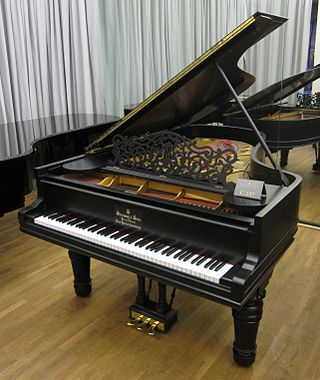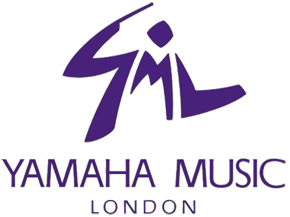
The oboe is a type of double-reed woodwind instrument. Oboes are usually made of wood, but may also be made of synthetic materials, such as plastic, resin, or hybrid composites.

The piano is a keyboard instrument that produces sound when its keys are depressed, through engagement of an action whose hammers strike strings. Most pianos have a row of 88 black and white keys, representing each note of the chromatic scale as they repeat throughout the keyboard's span of seven and a quarter octaves. There are 52 white keys, known as “naturals”, and 36 black keys, known as “sharps”. The naturals repeat a pattern of whole steps and half steps unique to any given starting note. These patterns define a diatonic scale. The 36 sharps repeat a pattern of whole steps and minor thirds, which defines a pentatonic scale.

A player piano, also known as a "Pianola", is a self-playing piano with a pneumatic or electro-mechanical mechanism that operates the piano action using perforated paper or metallic rolls. Modern versions use MIDI. The player piano gained popularity as mass-produced home pianos increased in the late 19th and early 20th centuries. Sales peaked in 1924 and subsequently declined with improvements in electrical phonograph recordings in the mid-1920s. The advent of electrical amplification in home music reproduction, brought by radios, contributed to a decline in popularity, and the stock market crash of 1929 virtually wiped out production.

Yamaha Corporation is a Japanese musical instrument and audio equipment manufacturer.

A multi-instrumentalist is a musician who plays two or more musical instruments, often but not exclusively at a professional level of proficiency.

Bösendorfer is an Austrian piano manufacturer and, since 2008, a wholly owned subsidiary of Yamaha Corporation. Bösendorfer is unusual in that it produces 97- and 92-key models in addition to instruments with standard 88-key keyboards.

The Radiodrum or radio-baton is a musical instrument played in three-dimensional space using two mallets. It was developed at Bell Labs in the 1980s, originally to be a three-dimensional computer mouse. Currently it is used as a musical instrument similar to a MIDI controller in the sense that it has no inherent sound or effect, but rather produces control signals that can be used to control sound-production As such, it can be thought of as a general telepresence input device. The radiodrum works in a similar way to the theremin, which uses magnetic capacitance to locate the position of the drumsticks. The two mallets act as antennas transmitting on slightly different frequencies and the drum surface acts as a set of antennas. The combination of the antenna signals is used to derive X, Y and Z.
Frederic Chiu is an American classical concert pianist.

Tod Machover, is a composer and an innovator in the application of technology in music. He is the son of Wilma Machover, a pianist and Carl Machover, a computer scientist.

The Bösendorfer Model 290 Imperial, or Imperial Bösendorfer (also colloquially known as the 290) is the largest model and flagship piano manufactured by Bösendorfer, at around 290 cm (9 ft 6 in) long, 176 cm (5 ft 9 in) wide, and weighing 552 kg (1,217 lb). It has an eight-octave range from C0 to C8. For 90 years it was the only concert grand piano in the world with 97 keys, until it was joined in 1990 by the instruments of Stuart & Sons of Australia. Music critic Melinda Bargreen has described the Imperial as the ne plus ultra of pianos, while pianist Garrick Ohlsson dubbed it the "Rolls-Royce of pianos".

Fernando Otero is a Grammy-award-winning Argentine pianist, vocalist, and composer.

Yamaha Entertainment Group of America, is a division of the American subsidiary of Yamaha Corporation. It is based in Franklin, Tennessee and was created and developed in 2001 by Vice President Chris Gero. YEG is responsible for the development and advancement of Yamaha brand name through numerous artist-related activities worldwide, which includes endorsements, artist imaging, artist marketing, concert production, media operations, piano logistics, tour support, product placement, artist related publications, artist website development and strategic alliances.

Disklavier is a brand of reproducing pianos manufactured by Yamaha Corporation. The first Disklavier was introduced in the United States in 1987.

Yamaha Artist Services, Inc. is a provider of professional services exclusively for performing music artists, concert venues, performing arts organizations and educational institutions. Located at 689 Fifth Avenue in Manhattan, New York City, YASI is owned by the American subsidiary of Yamaha Corporation and features rehearsal, recording and performance spaces for musicians.
Cathal Breslin is a concert pianist originally from Derry, Northern Ireland, now living in Phoenix, Arizona in the United States. He has performed extensively in solo recitals, as a concerto soloist with orchestra and a chamber musician in major concert halls throughout Europe, North America, South America and Asia.

Chris Gero is a Grammy nominated American music industry executive, concert producer, record producer, songwriter, film director and composer, founder of the Yamaha Entertainment Group of America, and Chief Artist Relations Executive for Yamaha Artist Relations Group. He is responsible for the management and branding of Yamaha's global roster, having signed more than 3,600 artists to contract to date. Gero oversees Yamaha's artist collaborations, including Elton John, Alicia Keys, Paul McCartney, Norah Jones, Josh Groban, Sarah McLachlan, Sheryl Crow, John Legend, and Ben Folds.
Tony Yike Yang is a Canadian-Chinese pianist.

Yamaha Music London is an English musical instrument and sheet music retail store owned and operated by Yamaha Music Europe GmbH's UK branch. It is located on Soho's Wardour Street, and the majority of the building has Grade II Listed status.
Synchron Stage Vienna is a recording facility specializing in recording large orchestras and film music. The landmark protected building, formerly "Synchronhalle" of the historic film lot "Film City Vienna" in the Austrian capital's 23rd district is operated by Vienna Symphonic Library.
Jeremy Siskind is an American pianist, composer, and educator known for his innovative blending of jazz and classical music.















